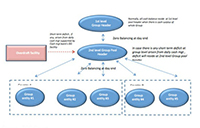Looking within to Drive Working Capital Optimisation
With rising funding costs and changing regulations, corporates are looking for solutions beyond financing. Corporate treasurers increasingly need to think across both the physical and financial supply chain when managing their cash flow. Working capital optimisation has become a core issue for all types of businesses, and they are looking to their banks to support them.

The rising importance of working capital efficiency
A DBS study estimates that there is more than $1 trillion in trapped cash (suboptimal working capital) within six core markets in Asia alone. This is a result of a seismic shift in demand, labour and supply chain management etc., all impacting the way businesses operate. The result? Increased trapped cash within their operations, hindering opportunities for profitability and growth.
Corporates in Asia are expanding rapidly, driven by domestic demand and cross-border trade flows. With growth comes teething pains and those same expanding companies are also facing the challenge of managing the inefficiencies in their working capital cycle.
Working capital optimisation, while more common in the Europe and US, will increasingly become a strategic focus for corporates in Asia as well. Beyond top-line growth, the next phase is likely to be driven by internal optimisation. To stay competitive, corporates need to understand the “new normal” in supply chain management to optimise their working capital.
Here are some key trends that are driving the convergence of physical and financial supply chain considerations for the treasurer.
New urban customers and customer differentiation
With the emergence of tier 2 cities across Asia, companies need to develop their own best practices to serve their clients. Some initiatives include (re)designing nimble supply chains and optimising customer and supplier management.
These have diverse implications across receivables, inventory and payables. As consumers embrace technology, companies also evolve into a “segment-of-one” model to cater to the new expectation of customised goods and services. Hence, supply chains need to be robust enough to accommodate these details.
Prudent risk management
A globalised, interconnected world means greater exposure and risks, causing supply chain disruptions. Whether natural or man-made, these events are hard to predict and cannot be avoided, and treasurers need to consider how to diversify and mitigate transactions risks; by diversifying your supplier base, for example.
Channel innovation and greener supply chains
Today, new payments and processing systems, diversified customers’ lifestyles etc have impacted commerce. Companies need to innovate to effectively reach and serve their customers more effectively. Sustainability is also a key corporate concern and supply chains have to become greener to meet consumers’ expectations or risk being black-listed.
As the external environment pose challenges for businesses in Asia, corporate treasurers start to look within for opportunities to optimise their working capital.
An industry-first working capital advisory programme
DBS has established itself as the working capital expert for its Asia-based clients. With the set up of a Working Capital Advisory programme, DBS identifies and advises clients on opportunities across both their physical and financial supply chains.
The programme provides CFOs, treasurers, and financial controllers with a methodical study of their business via industry benchmarks and operations-specific diagnostics, using proprietary data and analytical tools, as well as bespoke and deep-dive solutions to address their working capital inefficiencies.
DBS provides two types of analysis: Working Capital Benchmarks and Working Capital Diagnostics.
In working capital benchmarks, DBS provides industry and peer comparison for working capital ratios. The benchmarks will also indicate the key levers to uncover trapped cash in our treasurers’ working capital cycles.
For the working capital diagnostics, we partner with our customers to conduct detailed analysis of working capital drivers to develop actionable recommendations. Once a deep-dive analysis has been completed, DBS will target on areas where clients can unlock their trapped cash and realise tangible benefits from within, independent of any bank products.
The infrastructure of this programme caters to the full spectrum of corporates, regardless of industry, size, and geography. For SMEs, it provides complimentary access to insights and analytics, whereas for larger corporates, it provides better data visualisation and non-biased view of their working capital cycle.
Conclusion
As the needs of consumers continue to evolve, corporates need a bank that understands them holistically across both the physical and financial supply chain.
DBS is committed to help companies optimise their working capital cycle, and bring with us Asian insights to help fuel the next wave of corporate and transaction banking growth.
Subscribe to DBS BusinessClass
Stay updated with the latest market trends and industry insights, connect with a network of entrepreneurs, and gain access to exclusive event invitations. Join Asia's fastest growing business community – get your complimentary membership here.




